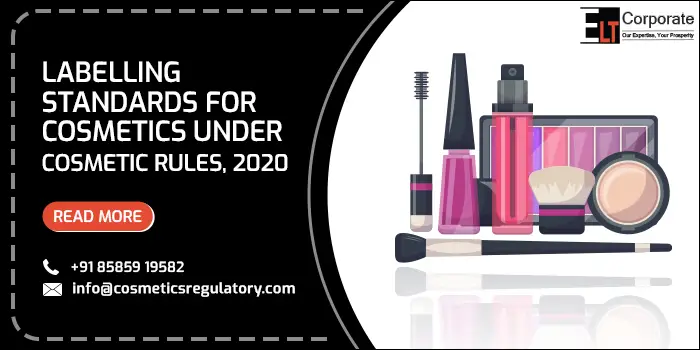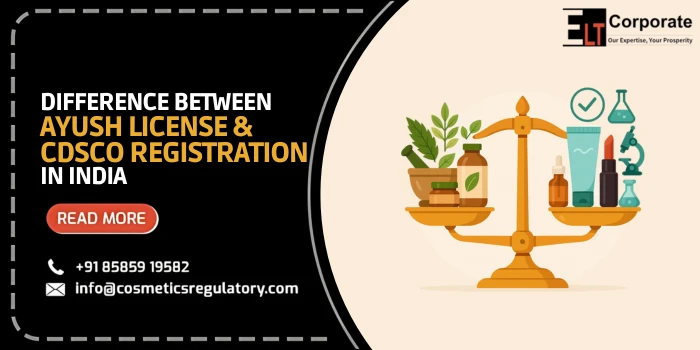Are you an importer or manufacturer of beauty products? It is crucial to know the cosmetics labeling standards under the CDSCO Cosmetics Rule, 2020 to enter the market. Complying with these requirements ensures that beauty products adhere to the regulatory standards and are reliable for consumers.
In this article, we will walk you through the key labeling standards for cosmetics, helping you navigate the process seamlessly and gain consumer trust. Let’s discover everything you need to know about cosmetic labeling to ensure business consistency.
What Are The Labeling Standards For Cosmetics?
CDSCO is the regulatory body introduced by the Ministry of Health and Family Welfare, which sets the cosmetics labeling standards for the manufacture, import, and sale of cosmetics in India. The regulatory body can decline the approval of product manufacturing or sale if the labeling standard doesn’t comply with the requirement.
Labeling compliance for cosmetics and standards as per Cosmetics Rule, 2020, ensure that the cosmetic products are safe for commercialization in the Indian market and have all the required information for approval as per the regulatory authority or state licensing authority. Labeling standards for cosmetics are typically categorized into (inner label),(outer label or wrapper), or a leaflet having a description of the product and other instructions.
Who can apply for Labeling Compliance of Cosmetics?
If you are reading this you must understand who can apply for the cosmetics labelling compliance. It is mandatory to be aware of the consumer the manufacturer & importers through labelling. If you are from the mentioned one then must apply for the labelling compliance consultancy:
- Manufacturers or Importers can apply for labeling compliance of cosmetic products.
- Anyone who wants to Import or Manufacture cosmetic products can apply.
- Any authorized person by the manufacturer or Importers can apply on their behalf.
What are Various Labeling Guidelines for Cosmetics as per CDSCO and Cosmetic Rule 2020?
The various necessary cosmetics labeling standards as per CDSCO and cosmetic rule 2020 for a seamless process of registration are as follows:
- Details mentioned on the label should be in English, Hindi, or both and must be easily understandable.
- Labels must be affixed as they remain stuck till the cosmetic product life cycle.
- Label design should be attractive, appealing, and eye-catching as consumers refer firstly to the label for product details.
- Warnings, precautions, and Dosage must be mentioned.
- All the details mentioned on the label must be correct and must be reviewed from official documents.
What Are The Cosmetics Labeling Standards For Inner & Outer Labels As Per The Cosmetics Rule, 2020?
For the cosmetics regulatory, you must understand the details that are necessary to mention on the Cosmetics product’s inner & outer labels:
Details On Both Inner And Outer Labels: –
- Name of the cosmetic
- Name and address of Manufacture
- Manufacturing or expiry date
- List of ingredients along with their percentages.
- Details on Inner or Outer label: –
- Batch number / Lot numberManufacturing License
Details On Inner Label( In case of hazards):-
- Any warning or cautions
- Direction for use
- Name of ingredients and quantities of hazardous
Details On Outer Label:-
- Net contents (weight in case of solid, fluid measure for liquids, and either one for semi-solid)
- Number of ingredients in case of more than one
What Are The Standards For Imported Cosmetics Labeling In India, Under Cosmetic Rule 2020?
The labeling standards for cosmetics imported will be the same as domestic manufactured cosmetic products. In addition, Importer details must be in case of Imported products. The following additional details must be added on the label in case of Imported products:
- Import registration certificate number.
- Name and address of Importer.
- For the country where the manufacturer doesn’t want to mention the manufacturing license during the import of cosmetic products, then a manufacturing license is not required in that case.
- When importers don’t want to mention the manufacturing site of cosmetics, then the country of origin where the product is manufactured will be mentioned only.
What are Labeling Standards For Cosmetics As Per CDSCO And Cosmetic Rules 2020?
In the case of the Import of cosmetics, its labeling must be according to the country in which it is going to be exported. The important that must be mentioned on the inner and outer labels are: –
- Name of the cosmetic products
- Date of expiry
- Name and address of manufacturer’s
- Batch number
- License number
- Symbols of international destinations are needed.
Exemptions Of Labeling Standards As Per Cosmetic Rules 2020:-
There are a few exemptions to labeling standards as per Cosmetic Rules 2020. They are as follows:
- Small-size containers have some relief in labeling.
- Hairs dyes containing color and pigment contain special instructions. (Rule 37))
- Toothpaste containing fluoride should contain caution and warning instructions
Conclusion
The labeling instructions of cosmetics should be as per Cosmetic Rule, 2020 and it is important to follow these rules to maintain customer safety, regulatory compliance, and also business promotion. Proper cosmetic labeling followed by any manufacturer or importer helps build customer trust and brand promotion because the label is the first thing customers look for before buying any product. So, labeling should be attractive and appealing to customers.
What Is The 12M Label on Cosmetics?
It represents that the product will expire after 12 months after the opening of the seal or lid.
Which Rule Should Be Followed For Cosmetic Label Compliance?
Rule number 34 of Cosmetic Rule, 2020 should be followed for Cosmetic product compliance.
In Which schedule Is The BIS For Cosmetics covered Under The New Cosmetic Rules 2020?
In Schedule Nine of New Cosmetic Rules, 2020 the BIS for cosmetics is mentioned.
What are the penalties for non-compliance with cosmetics labeling standards in India?
Non-compliance with cosmetics labeling standards in India can lead to fines, seizures, license suspension, or criminal charges, along with damage to brand reputation.



